wie der Vergleich
double K = iCustom(Symbol(),0,"zigzag",ExtDepth,ExtDeviation,ExtBackstep,0,i); if (K==Low[i] && K>0) //..low zigzag......
deVries,
Vielen Dank für Ihre prompte Antwort. Meinen Sie damit, dass Sie einfach den vorletzten Parameter von iCustom auf 0 ändern? Ich habe dies bereits versucht. und das Ergebnis ist definitiv nicht das, was ich wollte...Um meine Frage klarer zu machen, zeige ich die beiden Abbildungen unten, um meine Frage zu illustrieren....
Abb. 1: Unerwünschte Tops werden angezeigt, obwohl ich nur die Botoms anzeigen möchte! Ich möchte alle unerwünschten Tops herausfiltern, wenn ich nur die Bottoms anzeigen möchte.
FIg2. Die gewünschten Oberteile werden ohne unerwünschte Unterteile angezeigt. Das ist das Ergebnis, das ich haben möchte.
Meine Frage lautet also: Ist es möglich, nur die unteren Punkte anzuzeigen, ohne die Punkte A/B/C/D/E anzuzeigen? Ich hoffe, ich habe meine Frage klar formuliert.....
Vielen Dank für Ihre schnelle Antwort....
//+------------------------------------------------------------------+ //| Zigzag2.mq4 | //| Copyright © 2005-2007, MetaQuotes Software Corp. | //| http://www.metaquotes.net/ | //+------------------------------------------------------------------+ #property copyright "Copyright © 2007, MetaQuotes Software Corp." #property link "http://www.metaquotes.net/" #property indicator_chart_window #property indicator_buffers 3 #property indicator_color1 Red #property indicator_color2 Magenta #property indicator_color3 LightSkyBlue //---- indicator parameters extern int ExtDepth=12; extern int ExtDeviation=5; extern int ExtBackstep=3; //---- indicator buffers double ZigzagBuffer[]; double HighMapBuffer[]; double LowMapBuffer[]; int level=3; // recounting's depth bool downloadhistory=false; //+------------------------------------------------------------------+ //| Custom indicator initialization function | //+------------------------------------------------------------------+ int init() { IndicatorBuffers(3); //---- drawing settings SetIndexStyle(0,DRAW_SECTION); SetIndexStyle(1,DRAW_SECTION); SetIndexStyle(2,DRAW_SECTION); //---- indicator buffers mapping SetIndexBuffer(0,ZigzagBuffer); SetIndexBuffer(1,HighMapBuffer); SetIndexBuffer(2,LowMapBuffer); SetIndexEmptyValue(0,0.0); SetIndexEmptyValue(1,0.0); SetIndexEmptyValue(2,0.0); //---- indicator short name IndicatorShortName("ZigZag("+ExtDepth+","+ExtDeviation+","+ExtBackstep+")"); //---- initialization done return(0); } //+------------------------------------------------------------------+ //| | //+------------------------------------------------------------------+ int start() { int i, counted_bars = IndicatorCounted(); int limit,counterZ,whatlookfor; int shift,back,lasthighpos,lastlowpos; double val,res; double curlow,curhigh,lasthigh,lastlow; if (counted_bars==0 && downloadhistory) // history was downloaded { ArrayInitialize(ZigzagBuffer,0.0); ArrayInitialize(HighMapBuffer,0.0); ArrayInitialize(LowMapBuffer,0.0); } if (counted_bars==0) { limit=Bars-ExtDepth; downloadhistory=true; } if (counted_bars>0) { while (counterZ<level && i<100) { res=ZigzagBuffer[i]; if (res!=0) counterZ++; i++; } i--; limit=i; if (LowMapBuffer[i]!=0) { curlow=LowMapBuffer[i]; whatlookfor=1; } else { curhigh=HighMapBuffer[i]; whatlookfor=-1; } for (i=limit-1;i>=0;i--) { ZigzagBuffer[i]=0.0; LowMapBuffer[i]=0.0; HighMapBuffer[i]=0.0; } } for(shift=limit; shift>=0; shift--) { val=Low[iLowest(NULL,0,MODE_LOW,ExtDepth,shift)]; if(val==lastlow) val=0.0; else { lastlow=val; if((Low[shift]-val)>(ExtDeviation*Point)) val=0.0; else { for(back=1; back<=ExtBackstep; back++) { res=LowMapBuffer[shift+back]; if((res!=0)&&(res>val)) LowMapBuffer[shift+back]=0.0; } } } if (Low[shift]==val) LowMapBuffer[shift]=val; else LowMapBuffer[shift]=0.0; //--- high val=High[iHighest(NULL,0,MODE_HIGH,ExtDepth,shift)]; if(val==lasthigh) val=0.0; else { lasthigh=val; if((val-High[shift])>(ExtDeviation*Point)) val=0.0; else { for(back=1; back<=ExtBackstep; back++) { res=HighMapBuffer[shift+back]; if((res!=0)&&(res<val)) HighMapBuffer[shift+back]=0.0; } } } if (High[shift]==val) HighMapBuffer[shift]=val; else HighMapBuffer[shift]=0.0; } // final cutting if (whatlookfor==0) { lastlow=0; lasthigh=0; } else { lastlow=curlow; lasthigh=curhigh; } for (shift=limit;shift>=0;shift--) { res=0.0; switch(whatlookfor) { case 0: // look for peak or lawn if (lastlow==0 && lasthigh==0) { if (HighMapBuffer[shift]!=0) { lasthigh=High[shift]; lasthighpos=shift; whatlookfor=-1; ZigzagBuffer[shift]=lasthigh; res=1; } if (LowMapBuffer[shift]!=0) { lastlow=Low[shift]; lastlowpos=shift; whatlookfor=1; ZigzagBuffer[shift]=lastlow; res=1; } } break; case 1: // look for peak if (LowMapBuffer[shift]!=0.0 && LowMapBuffer[shift]<lastlow && HighMapBuffer[shift]==0.0) { ZigzagBuffer[lastlowpos]=0.0; lastlowpos=shift; lastlow=LowMapBuffer[shift]; ZigzagBuffer[shift]=lastlow; res=1; } if (HighMapBuffer[shift]!=0.0 && LowMapBuffer[shift]==0.0) { lasthigh=HighMapBuffer[shift]; lasthighpos=shift; ZigzagBuffer[shift]=lasthigh; whatlookfor=-1; res=1; } break; case -1: // look for lawn if (HighMapBuffer[shift]!=0.0 && HighMapBuffer[shift]>lasthigh && LowMapBuffer[shift]==0.0) { ZigzagBuffer[lasthighpos]=0.0; lasthighpos=shift; lasthigh=HighMapBuffer[shift]; ZigzagBuffer[shift]=lasthigh; } if (LowMapBuffer[shift]!=0.0 && HighMapBuffer[shift]==0.0) { lastlow=LowMapBuffer[shift]; lastlowpos=shift; ZigzagBuffer[shift]=lastlow; whatlookfor=1; } break; default: return; } } return(0); } //+------------------------------------------------------------------+
Es war möglich, nur den Zickzack-Puffer anzuzeigen
Zickzack wird neu gemalt
siehe Ergebnis
Hier ist, was ich herausgefunden habe. Ich habe deVries Ergebnisse oben nicht überprüft [ich tat dies, als er gepostet hat].
#property indicator_chart_window #property indicator_buffers 2 #property indicator_color1 Green #property indicator_width1 1 #property indicator_color2 Yellow #property indicator_width2 1 double Bottoms[]; double Toppers[]; int init() { IndicatorBuffers(2); SetIndexStyle(0,DRAW_SECTION); SetIndexBuffer(0,Bottoms); SetIndexEmptyValue(0,0.0); SetIndexStyle(1,DRAW_SECTION); SetIndexBuffer(1,Toppers); SetIndexEmptyValue(1,0.0); IndicatorShortName("zz show top & bottom"); return(0); } int deinit() { return(0); } int start() { int counted_bars=IndicatorCounted(); int limit=0; limit = Bars-counted_bars; for(int shift=limit-1;shift>=0;shift--) { int ExtDepth=12; int ExtDeviation=5; int ExtBackstep=3; int ZigzagBuffer=0; int HighMapBuffer=1; int LowMapBuffer=2; Bottoms[shift]=iCustom( Symbol(),0,"ZigZag", ExtDepth, ExtDeviation, ExtBackstep, LowMapBuffer, shift ); Toppers[shift]=iCustom( Symbol(),0,"ZigZag", ExtDepth, ExtDeviation, ExtBackstep, HighMapBuffer, shift ); if(Bottoms[shift]>0.1) Bottoms[shift]=Bottoms[shift]; if(Toppers[shift]>0.1) Toppers[shift]=Toppers[shift]; } return(0); }
Hier ist, was ich herausgefunden habe. Ich habe deVries Ergebnisse oben nicht überprüft [ich tat dies, als er gepostet hat].
#property indicator_chart_window #property indicator_buffers 3 #property indicator_color1 Red #property indicator_width1 3 #property indicator_color2 Green #property indicator_width2 3 #property indicator_color3 Yellow #property indicator_width3 3 //---- indicator parameters extern int ExtDepth=12; extern int ExtDeviation=5; extern int ExtBackstep=3; double ZigZag[]; double Bottoms[]; double Toppers[]; int init() { IndicatorBuffers(3); SetIndexStyle(0,DRAW_SECTION); SetIndexBuffer(0,ZigZag); SetIndexEmptyValue(0,0.0); SetIndexStyle(1,DRAW_SECTION); SetIndexBuffer(1,Bottoms); SetIndexEmptyValue(1,0.0); SetIndexStyle(2,DRAW_SECTION); SetIndexBuffer(2,Toppers); SetIndexEmptyValue(2,0.0); IndicatorShortName("zz show top & bottom"); return(0); } int deinit() { return(0); } int start() { int counted_bars=IndicatorCounted(); int limit=0; limit = Bars-counted_bars; for(int shift=limit-1;shift>=0;shift--) { ZigZag[shift]=iCustom( Symbol(),0,"ZigZag", ExtDepth, ExtDeviation, ExtBackstep, 0, shift ); if(ZigZag[shift]>0.1 && Low[shift]==ZigZag[shift]) Bottoms[shift]=ZigZag[shift]; if(ZigZag[shift]>0.1 && High[shift]==ZigZag[shift]) Toppers[shift]=ZigZag[shift]; } return(0); }
Dies ist das Ergebnis
jetzt stimmen unten und oben alle mit Zickzack überein
deVries:
Nice ubzen mit Hilfe Ihres Codes kam ich zu diesem......Das gibt als Ergebnis
jetzt passen unten und oben alle mit Zickzack
Hallo deVries,
vielen Dank für Ihren Code. Wenn ich wissen möchte, wie weit das Fibonacci Retracement des letzten Zickzackschenkels im Vergleich zum vorherigen Zickzackschenkel ist. Wie kann man das machen?
Ich möchte wie das Bild zu tun, aber der Code unten, dass ich versuchte, machte es nicht ...
Danke!
Buchse
#property indicator_chart_window #property indicator_buffers 3 #property indicator_color1 Red #property indicator_width1 3 #property indicator_color2 Green #property indicator_width2 3 #property indicator_color3 Yellow #property indicator_width3 3 //---- indicator parameters extern int ExtDepth=12; extern int ExtDeviation=5; extern int ExtBackstep=3; double ZigZag[]; double Bottoms[]; double Toppers[]; double resBuffer[][]; //--- int init() { IndicatorBuffers(3); SetIndexStyle(0,DRAW_SECTION); SetIndexBuffer(0,ZigZag); SetIndexEmptyValue(0,0.0); SetIndexStyle(1,DRAW_SECTION); SetIndexBuffer(1,Bottoms); SetIndexEmptyValue(1,0.0); SetIndexStyle(2,DRAW_SECTION); SetIndexBuffer(2,Toppers); SetIndexEmptyValue(2,0.0); IndicatorShortName("zz show top & bottom"); return(0); } int deinit() { ObjectDelete("myFibo"); return(0); } int start() { int counted_bars=IndicatorCounted(); int limit=0; limit = Bars-counted_bars; int k=0, m=0; int candle1=0, candle2=0; double prc1=0, prc2=0; for(int shift=limit-1;shift>=0;shift--) { ZigZag[shift]=iCustom( Symbol(),0,"ZigZag", ExtDepth, ExtDeviation, ExtBackstep, 0, shift ); if(ZigZag[shift]>0.1 && Low[shift]==ZigZag[shift]) { Bottoms[shift]=ZigZag[shift]; resBuffer[k][0] = Bottoms[shift]; resBuffer[k][1] = shift; k++; } if(ZigZag[shift]>0.1 && High[shift]==ZigZag[shift]) { Toppers[shift]=ZigZag[shift]; resBuffer[k][0] = Toppers[shift]; resBuffer[k][1] = shift; k++; } } // ende for //--- for(m=k;m>=0;m--) { candle1 = resBuffer[m][1]; prc1 = resBuffer[m][0]; candle2 = resBuffer[m-1][1]; prc2 = resBuffer[m-1][0]; //--- ObjectDelete("myFibo"); ObjectCreate("myFibo", OBJ_FIBO, 0, Time[candle1], prc2, Time[candle2], prc1); } // ende for return(0); }
Hallo deVries,
vielen Dank für Ihren Code. Wenn ich wissen möchte, wie weit das Fibonacci Retracement des letzten Zickzackbeines im Vergleich zum vorherigen Zickzackbein ist. Wie kann man das machen?
Danke!
jack
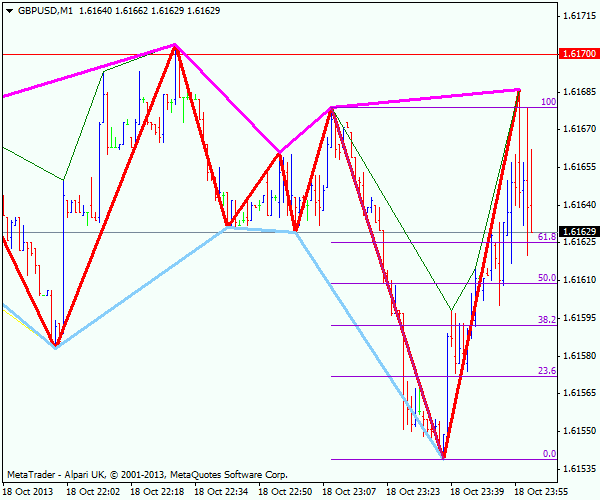
Zeichnen Sie Fibonacci auf diese Weise finden Sie die beiden Punkte mit Zickzack-Indikator iCustom
0.0 1.6154
100.0 1.6168
Differenz 0,0014
letzter Höchststand = 1,6169
Differenz mit 0.0 0.0015 in% 0.0015/0.0014 * 100% = 107% im Abstand + 0.0001
Ist es das, was Sie meinen?
Hallo deVries,
vielen Dank. Ja, es ist wie das Bild, das du geschickt hast. Aber ich möchte wissen, wie man es codiert. Es muss jedes vorherige Zigzag Bein berechnen, und dann das Fibonacci Level zeichnen, damit wir wissen, wie weit das aktuelle / letzte Zigzag geht.
edit: Ich habe den Code im vorherigen Posting gesendet. Es würde nicht zeichnen die Fibo-Linie ...
Danke
- Freie Handelsapplikationen
- Über 8.000 Signale zum Kopieren
- Wirtschaftsnachrichten für die Lage an den Finanzmärkte
Sie stimmen der Website-Richtlinie und den Nutzungsbedingungen zu.


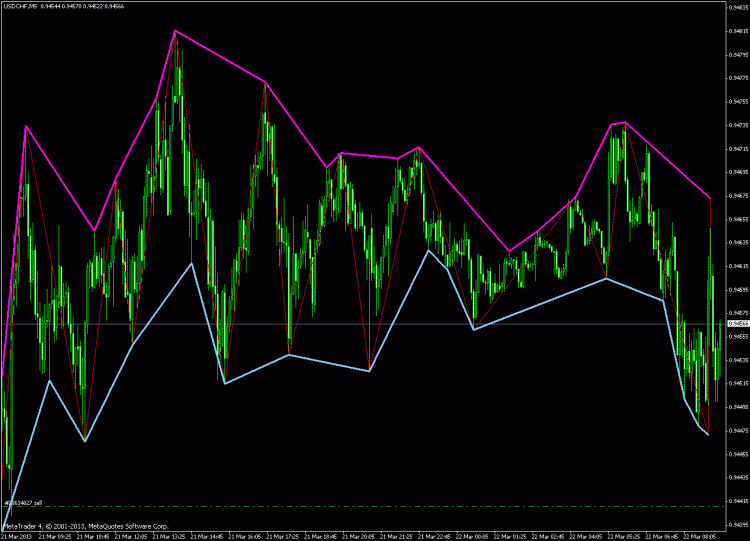
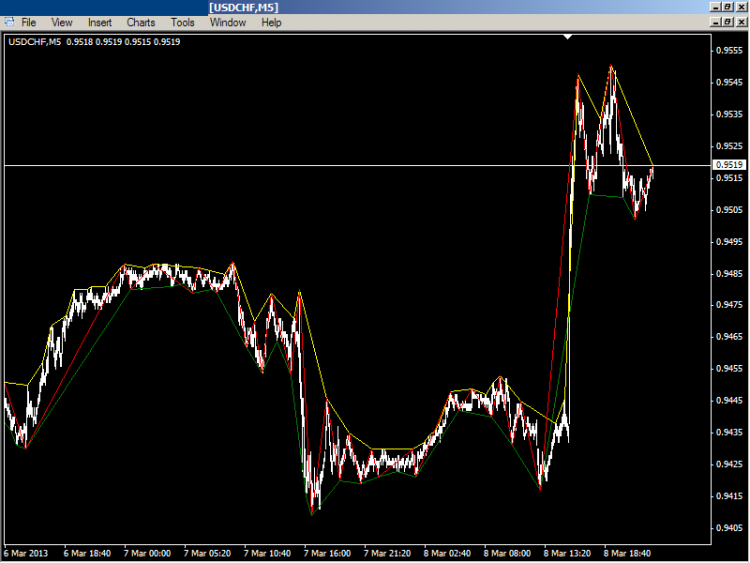
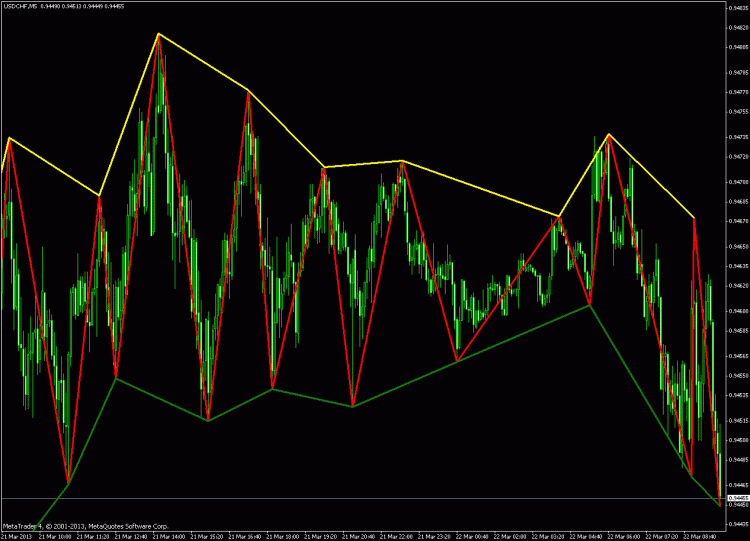
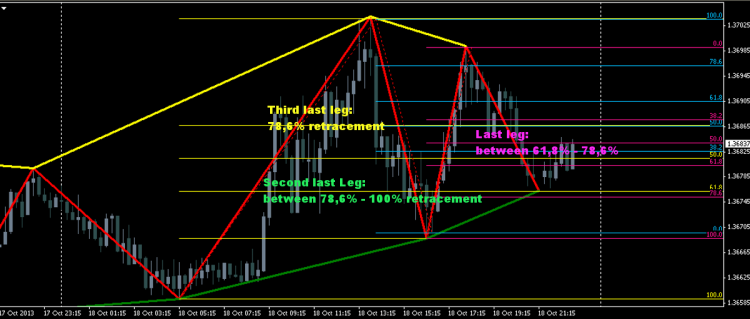
Sehr geehrte Damen und Herren, wie kann man den Code ändern, um nur die Tiefpunkte des Zickzack-Indikators anzuzeigen?